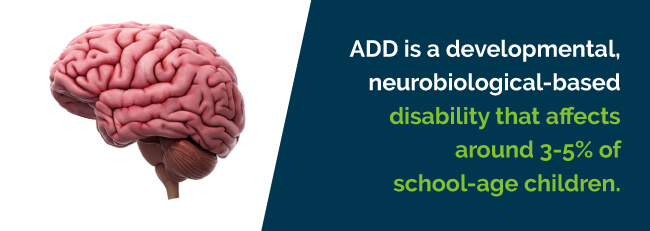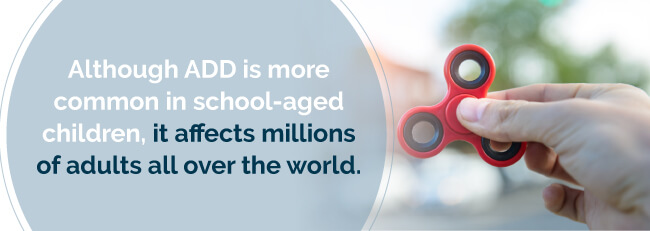A developmental condition like attention deficit disorder (ADD) is a condition with symptoms that medical marijuana may be able to treat. Because ADD can cause symptoms like impulsivity, restlessness and inattention that can interfere with work or school, it’s important to manage the condition with a treatment like cannabis. Let’s explore more about ADD, its symptoms and how marijuana and attention deficit disorder treatment can help you.
Having to live with ADD can be paralyzing and stressful. However, many ADD patients have found relief and comfort using medical marijuana. In fact, a 2014 study suggests that people who are impulsive and hyperactive tend to be more likely to turn to weed.
Cannabis can help sufferers of this condition with being able to pay attention, focus their attention on a specific subject, and formulate ideas in their head that they could not before. Cannabis truly helps ADD sufferers stay on task and help them keep their lives on track. Marijuana, in its most natural form, is one of the safest and therapeutically active substances known to man.
Find A Doctor Find A Dispensary
The benefits of medical cannabis for ADD are undeniable — as acceptance of this form of medicine continues to increase nationwide, hopefully, more patients will one day be able to take advantage of it.
A 2009 study explained the interconnection between the endocannabinoid system in ADD patients and dopamine. An ADD diagnosis means you have more anandamide, which is a neurotransmitter that binds to the THC receptor.
In ADD patients, the fatty acid amide hydrolase (FAAH), the enzyme needed to break down anandamide, is insufficient. When this type of imbalance occurs in your body, you run out of your dopamine supply too quickly, making it hard to focus. Taking marijuana, however, regulates this dopamine supply and your mood.
Some symptoms of ADD treatable with marijuana include:
Here are some other ways marijuana can act beneficially:
Patients also experienced improved sleep in other cases. All of the participants used a medical flower and dronabinol, a THC drug used for treating nausea and vomiting. Even though it was a small case study, researchers were still confident that marijuana is an effective treatment option for ADD patients, particularly those who don’t respond well to typical treatment methods.
For you to qualify for medical cannabis, you need to have a diagnosed condition (in this case ADD) that’s on your state’s list of conditions that qualify for medical weed. With a doctor’s recommendation, you can obtain your medical cannabis card and visit dispensaries to buy your cannabis products.
A lot of patients who have ADD are children, making smoking medical marijuana problematic. One effective alternative method is a tincture. It is a liquid, such as oil, that is an extract of cannabis. This extract sometimes consists of the leaves of the plant, but more often, it consists of the buds or flowers.
You take tinctures in the form of drops administered to the gums. Tinctures are extracted from a particular strain, or they can be a hybrid of multiple strains. These liquids tend to be highly concentrated, meaning patients don’t need to take a lot to get the amount of medication they need to find relief.
Much like smoking, tinctures will usually take effect very quickly — in as little as a few seconds, in some instances. Patients often report feelings of calm almost immediately after administering a dose. But it can take a while to determine exactly how much to take. Some people find they may need to take a bit more to achieve the effects they’re looking for.
Many tinctures, however, have a somewhat bitter taste when taken in their concentrated form. Some patients find that mixing a tincture with their favorite morning beverage or in a mild tea at night will produce beneficial effects without the unpleasant taste.
When receiving an ADD diagnosis, you’ll need help concentrating. Certain cannabis strains can help you stay productive and focused while others provide a calming effect.
Mental engagement and energy strains may include:
Calming focus strains include:
There are also strains that help you through the side effects of ADD medication like lack of appetite and insomnia. These include:
When using medical pot for medical purposes, remember that like with any medication, there could be side effects. However, the side effects of this herb tend to be less harsh as those of traditional medicine. Some side effects may include:
Both anecdotal and clinical evidence suggest cannabis as a therapeutic treatment for ADHD is on the rise. This includes reports through online resources. Out of 268 forum threads found online, 25 percent of the 401 posts in the threads indicated marijuana is therapeutic for ADHD.
Now that you’ve learned how effective medical marijuana for Attention Deficit Disorder can be, let’s take a closer look at what ADD is, its symptoms, treatments and other essential information.
ADD is a developmental, neurobiological-based disability that affects around three to five percent of school-age children.

Many people use ADHD and ADD interchangeably. The official name for ADD is Attention Deficit Hyperactivity Disorder. However, even some professionals continue to call the disorder by the name given in 1980: ADD. Scientific field trial findings and advances changed the name to what it is currently. Today, researchers have supportive evidence that reveals ADD isn’t a single specific disorder. Rather, it has several variations.
Based on the primary features associated with the condition, there are now three subtypes of ADD. Behavior symptoms are divided into impulsivity, inattentiveness and hyperactivity. The three subtypes for ADD are:
These subtypes acknowledge that some ADD patients have little or no trouble sitting still, but they will show inattentiveness leading to great difficulty staying focused on activities or tasks.
Other ADD patients might have no issues paying attention to an activity or task. However, they end up losing focus because they’re predominantly hyperactive-impulsive, which results in them having difficulty controlling movement and impulse.
The combined type is the most prevalent subtype. With this type, your symptoms are indicative of three of these characteristics:
Although the exact cause at Attention Deficit Disorder isn’t known, genetics and heredity seem to be a significant factor in the development of ADD. Lead exposure, certain illnesses like encephalitis or meningitis and exposure to substances like cigarette smoking and alcohol in-utero also increase the risk of developing ADD.
According to the National Institute of Mental Health:
ADD has been called by many names through history since its first medical research recording in the late 1700’s. In 1968, it was included in health professionals’ diagnostic manuals. And, for a while, ADD was called “Minimal Brain Dysfunction.” As understanding and research of this disorder continued to grow over the decades, the description and diagnosis name of the disorder evolved.
Tests on lab rats in the 1940s showed that Ritalin could increase manageability and focus in those with the ADD, which didn’t become officially recognized as a disorder until the 1980s. Adderall was the next drug released in 1996.
ADD diagnoses have been increasing in children, too — rising from 7.8 percent in 2003 to 9.5 percent in 2007 and then again to 11 percent in 2011-12.

ADD isn’t a disorder that affects only children. Even though symptoms may develop in your childhood years, the condition can continue into adulthood. While hyperactivity seems to improve as a teenager, you may experience ongoing struggles with issues like disorganization, inattention and poor impulse control.

Your ADD symptoms can range from mild to severe, depending on your environment and physiology. You may be mildly hyperactive and inattentive when performing a task you don’t like but can maintain focus on those you enjoy. Or you may struggle with more severe symptoms that can impact your work and social situations.
Furthermore, if you have another condition like anxiety or depression, it can worsen your symptoms.
Symptoms in adults can manifest differently than those in children. You may find trouble with executive functioning which is another prominent characteristic of ADD. Executive functioning is brain activity that manages your ability to monitor behavior by organizing and planning. Other symptoms you may experience include impulsivity and inattention and restlessness.
You may also experience learning, behavioral and emotional problems.
When dealing with hyperactive-impulsive symptoms, you may continuously feel “on the go” and restless as you attempt various tasks at once. You often speak and act before you think.
ADD currently has no cure. However, some treatments can help to improve functioning and reduce your symptoms. Common ADD treatments include medication, therapy or a combination of both.
For many patients with ADD, medications reduce impulsivity and hyperactivity. Medications may also improve your ability to learn, focus and work. Stimulants are typically the first line of treatment for ADD.
Although stimulants may sound a little unusual for treating ADD, they are effective. Researchers believe they’re useful because they increase brain levels of dopamine, which plays a significant role in attention and thinking. Examples of stimulants include methylphenidate or amphetamine.
Side effects of stimulants may include:
Non-stimulants take longer than stimulants to begin working, but they still help to improve impulsivity, focus and attention in patients with ADD. Your doctor may prescribe a non-stimulant if you’ve been experiencing troubling stimulant side effects or if stimulant medication hasn’t been effective. Examples of non-stimulants include guanfacine and atomoxetine.
Depending on the non-stimulant medication, side effects may include:
Although the FDA hasn’t necessarily approved antidepressants for the use of treating ADD specifically, doctors sometimes prescribe them to adult ADD patients. Tricyclics are the common antidepressants prescribed. They work similarly to stimulants by affecting the brain chemicals dopamine and norepinephrine.
Some side effects of antidepressants may include:
Various brands of antidepressants have their potential side effects and benefits. Your doctor may have to try out a few different types or dosages before finding the one best suited for your symptoms.
Therapy is another ADD treatment, but it may not treat ADD symptoms effectively. Nonetheless, when your doctor adds therapy to medication or another ADD treatment plan, it may help you and your family cope with the everyday challenges of ADD better.
In children and teens, teachers and parents can help with following directions and staying organized with tools like keeping a schedule and routine, giving rewards and praise for good behavior and using notebook and homework organizers.
In adults, a therapist or mental health provider can help manage ADD with tools like breaking large tasks into smaller tasks and keeping routines.
If you’re looking to treat your ADD symptoms but don’t want to suffer with the harsh side effects of the medications for it, medical cannabis may be a better alternative.
As with all forms of medicinal marijuana, you need to have an extended talk with your or your child’s doctor to determine the best way to administer medical cannabis for ADD. If your doctor believes that marijuana would be beneficial, talk to an expert at your local dispensary to find out the strains that are typically most effective for treating the condition.
If you’ve been on the fence about trying cannabis for attention deficit disorder, you may want to talk with others who have had success in using it for treatment. When you’re ready to give it a try, search for a medical marijuana doctor.
Find A Doctor Find A Dispensary